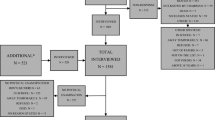Abstract
There is unequal access to surgical health care in underdeveloped countries such as Bangladesh. Bangladesh has a large young population, with 70 % of the population living in rural areas. All of the pediatric surgical services of the country are situated in major cities. We therefore organized an outreach service with the aim of providing surgical services to these rural children by utilizing the existing facilities of primary and secondary care centers. The program originated at the Department of Pediatric Surgery, Chittagong Medical College and Hospital in Sept 2008. The data presented here are from its 2008 beginning to Nov 2011. A yearly plan is sent to the Divisional Director of Health Services for Chittagong Division, who notifies all of the concerned district hospitals (DHs) and Upazila Health Complexes (UHCs). A member of the outreach team contacts each center via telephone 1 month prior to the visit to help organize it. Doctors at each participating hospital in which day surgery is possible are informed as to which commonly performed day surgeries are available, and they then select the appropriate patients to be examined at that visit. The local doctors are also advised to choose other pediatric surgical patients as outpatients. The local doctors perform the follow-up. If necessary, patients are referred to our department for further management. During the study period, we made 32 visits to 5 DHs and 10 UHCs. In all, 674 children were seen as outpatients, and 407 underwent surgery, of which inguinal hernia repair was the most common. There were no deaths. Outreach service is a good way to extend curative care to the grass-roots population.

Similar content being viewed by others
References
Farmer PE, Kim JY (2008) Surgery and global health: a view from beyond the OR. World J Surg 32:533–536. doi:10.1007/s00268-008-9525-9
McQueen KA, Ozgediz D, Riviello R et al (2010) Essential surgery: integral to the right to health. Health Hum Rights 12:137–152
Weiser TG, Regenbogen SE, Thompson KD et al (2008) An estimation of the global volume of surgery: a modelling strategy based on available data. Lancet 372:139–144
Mock C, Nguyen S, Quansah R et al (2006) Evaluation of trauma care capabilities in four countries using the WHO-IATSIC guidelines for essential trauma care. World J Surg 30:946–956. doi:10.1007/s00268-005-0768-4
Bangladesh Bureau of Statistics (2011) Population & housing census 2011. http://www.bbs.gov.bd/WebTestApplication/userfiles/Image/Census2011/Bangladesh_glance.pdf. Accessed 21 July 2012
Anonymous (2004) Bangladesh Demographic and Health Survey 2004. National Institute of Population Research and Training (NIPORT) Dhaka, Bangladesh, p 12
Bangladesh Bureau of Statistics (2011) Preliminary Report on Household Income & Expenditure Survey—2010. http://www.bbs.gov.bd/WebTestApplication/userfiles/Image/HIES/HIES-PR.pdf. Accessed 11 Oct 2011
UNICEF Bangladesh. Child Survival in Bangladesh. Available at: http://www.unicef.org/bangladesh/Child_Surviva_in_Bangladesh.pdf
Jahan NA (2011) A Situation Analysis Report on Health (MDG 4, 5, and 6) Bangladesh: A Baseline for Needs Assessment and Costing. http://www.undp.org.bd/projects/prodocs/PRS_MDG/Situation%20analysis_health.pdf/. Accessed 28 Aug 2011
Sirajuddin AS, Siddique AK, Iqbal A et al (2010) Causes for hospitalizations at Upazila Health Complexes in Bangladesh. J Health Popul Nutr 28:399–404
Ahmad A (2003) Provision of primary health care in Bangladesh: an institutional analysis. Presented at the Conference on Development Research at Lund University, p 19
Adigun AI, Adeogba AO, Sims ML et al (2008) Plastic surgical outreach services in a developing country: the challenges. World J Med Sci 2:96–100
Ahmed SA, Hossain MA, Mushtaque A et al (2011) The health workforce crisis in Bangladesh: shortage, inappropriate skill-mix and inequitable distribution. Hum Resour Health 9:3
Directorate General of Health Services (DGHS), Government of People’s Republic of Bangladesh. Health Situation of Bangladesh. http://www.dghs.gov.bd/index.php?option=com_content&view=article&id=69&Itemid=91&lang=en. Accessed 12 Oct 2011
Health Care Network of Bangladesh Under the Ministry of Health & Family Welfare. http://dghs.gov.bd/dmdocuments/Bangladesh%20Health%20Network.pdf. Accessed 11 Oct 2011
Mock C, Cherian M, Juillard C et al (2010) Developing priorities for addressing surgical conditions globally: furthering the link between surgery and public health policy. World J Surg 34:381–385. doi:10.1007/s00268-009-0263-4
Sariego J (1993) Patterns of surgical practice in a small rural hospital. J Am Coll Surg 189:8–10
Humber N, Frecker T (2008) Rural surgery in British Columbia: is there anybody out there? Can J Surg 51:179–184
O’Malley AS, Reschovsky JD (2011) Referral and consultation communication between primary care and specialist physicians: finding common ground. Arch Intern Med 171:56–65
Stille CJ, Primack WA (2011) Interspecialty communication: old problem, new hope? Arch Intern Med 171:1300
Samuels MA (2011) The importance of collaboration among physicians. Arch Intern Med 171:1301
Chen AH, Yee HF (2011) Improving primary care–specialty care communication: lessons from San Francisco’s safety net: comment on “Referral and consultation communication between primary care and specialist physicians.”. Arch Intern Med 171:65–67
Liss DT, Chubak J, Anderson ML et al (2011) Patient-reported care coordination: associations with primary care continuity and specialty care use. Ann Fam Med 9:323–329
Van Weel C, Roberts R, De Maeseneer J et al (2011) Public health: profession, health system, government control. Lancet 378:468–469
Shively EH, Shively SA (2005) Threats to rural surgery. Am J Surg 190:200–205
Anonymous (2012) Global surgery—the final frontier? Lancet 379:194. http://www.lancet.com/journals/lancet/article/PIIS0140-6736%2812%2960083-X/fulltext. Accessed 7 June 2012
Author information
Authors and Affiliations
Corresponding author
Appendix 1
Appendix 1
Guidelines for selecting patients for outreach service
-
1.
Patients in whom day surgery can be done (e.g., inguinal hernia, undescended testis, distal hypospadias, angular dermoid, lipoma, tongue-tied)
-
2.
Patients who do not require preoperative investigations (e.g., no complaints of respiratory distress, convulsion, bleeding manifestations)
-
3.
Patients who are clinically fit for anesthesia (e.g., no anemia, normal chest examination, no urinary complaints)
-
4.
Patients who do not require extensive postoperative monitoring
-
5.
Patients whose guardians have provided informed consent for an operation
-
6.
Patients who seek pediatric surgical consultations
Rights and permissions
About this article
Cite this article
Banu, T., Chowdhury, T.K., Kabir, M. et al. Bringing Surgery to Rural Children: Chittagong, Bangladesh Experience. World J Surg 37, 730–736 (2013). https://doi.org/10.1007/s00268-013-1916-x
Published:
Issue Date:
DOI: https://doi.org/10.1007/s00268-013-1916-x




